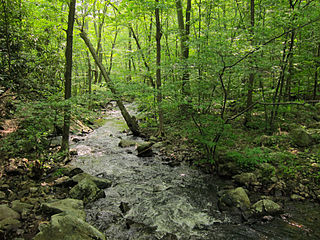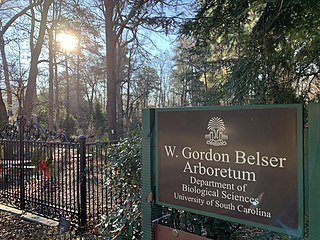
The chestnuts are the deciduous trees and shrubs in the genus Castanea, in the beech family Fagaceae. The name also refers to the edible nuts they produce. They are native to temperate regions of the Northern Hemisphere.

The American chestnut is a large, fast-growing deciduous tree of the beech family native to eastern North America. As is true of all species in the genus Castanea, the American chestnut produces burred fruit with edible nuts. The American chestnut was one of the most important forest trees throughout its range.

The pathogenic fungus Cryphonectria parasitica is a member of the Ascomycota. This necrotrophic fungus is native to East Asia and South East Asia and was introduced into Europe and North America in the early 1900s. The fungus spread rapidly and caused significant tree loss in both regions.

Castanea sativa, the sweet chestnut, Spanish chestnut or just chestnut, is a species of tree in the family Fagaceae, native to Southern Europe and Asia Minor, and widely cultivated throughout the temperate world. A substantial, long-lived deciduous tree, it produces an edible seed, the chestnut, which has been used in cooking since ancient times.

The Northeastern coastal forests are a temperate broadleaf and mixed forests ecoregion of the northeast and middle Atlantic region of the United States. The ecoregion covers an area of 34,630 sq miles (89,691 km2) encompassing the Piedmont and coastal plain of seven states, extending from coastal southwestern Maine, southeastern New Hampshire, eastern Massachusetts, and Rhode Island, southward through Connecticut, New York State, New Jersey, southeast Pennsylvania, Delaware and Maryland.

Castanea crenata, the Japanese chestnut or Korean chestnut, is a species of chestnut native to Japan and Korea. Castanea crenata exhibits resistance to Phytophthora cinnamomi, the fungal pathogen that causes ink disease in several Castanea species. The mechanism of resistance of Castanea crenata to Phytophthora cinnamomi may derive from its expression of the Cast_Gnk2-like gene.

Castanea pumila, commonly known as the Allegheny chinquapin, American chinquapin or dwarf chestnut, is a species of chestnut native to the southeastern United States. The native range is from Massachusetts and New York to Maryland and extreme southern New Jersey and southeast Pennsylvania south to central Florida, west to eastern Texas, and north to southern Missouri and Kentucky. The plant's habitat is dry sandy and rocky uplands and ridges mixed with oak and hickory to 1000 m elevation. It grows best on well-drained soils in full sun or partial shade.

Castanea mollissima, also known as the Chinese chestnut, is a species of chestnut tree in the family Fagaceae that is native to China, Taiwan, and Korea.

W. Gordon Belser Arboretum is part of the University of South Carolina in Columbia, South Carolina, managed by the Department of Biological Sciences. The arboretum serves as a nature preserve, field laboratory and research site for students and faculty. It is open to the public at a monthly open house. A small botanic garden features shrubs and small trees suitable for Columbia's home landscapes. The remaining landscape features southeast native trees and plant communities and is a certified Palmetto Wildlife Habitat.

Meadowview is a census-designated place (CDP) in Washington County, Virginia, United States. The population was 861 at the 2020 census. down from 967 at the 2010 census.

The American Chestnut Cooperators Foundation (ACCF) is a 501(c)(3) non-profit, scientific, and educational foundation that was organized in 1984 and, with the help of research and volunteers from Virginia Tech University, is dedicated to restoring the American chestnut to its former place in the United States Eastern hardwood forests.
A doubled haploid (DH) is a genotype formed when haploid cells undergo chromosome doubling. Artificial production of doubled haploids is important in plant breeding.
The New York State College of Forestry, the first professional school of forestry in North America, opened its doors at Cornell University, in Ithaca, New York, in the autumn of 1898., It was advocated for by Governor Frank S. Black, but after just a few years of operation, it was defunded in 1903, by Governor Benjamin B. Odell in response to public outcry over the College's controversial forestry practices in the Adirondacks.
A conservation management system (CMS) is a procedure for maintaining a species or habitat in a particular state. It is a means whereby humankind secures wildlife in a favourable condition for contemplation, education or research, in perpetuity. It is an important topic in cultural ecology, where conservation management counterbalances the unchecked exploitative management of natural resources. Conservation management systems are vital for turning sustainable development strategies into successful operations.

A genetically modified tree is a tree whose DNA has been modified using genetic engineering techniques. In most cases the aim is to introduce a novel trait to the plant which does not occur naturally within the species. Examples include resistance to certain pests, diseases, environmental conditions, and herbicide tolerance, or the alteration of lignin levels in order to reduce pulping costs.
Charles Russell Burnham (1904–1995) was an American plant geneticist who studied maize cytology and genetics. In 1968 he was elected a fellow of the American Society of Agronomy. After his retirement he played a critical role in developing a blight resistant strain of the American chestnut.
The Precoce Migoule is a chestnut hybrid, a natural cross between a European chestnut and a Japanese chestnut. It was discovered by J. Dufrenoy at the orchard of Migoule in Brive-la-Gaillarde. The tree is vigorous and erect growing with growth of a metre or more in a season if the conditions are right. It is a large sized chestnut tree with height reaching 20 m or more and 7.5-10 m wide. Trees start to bear after 3 to 5 years. Full nut production in 12 - 20 years depending on the location.
Marsol is a natural chestnut hybrid, a cross between a European chestnut and Japanese.

Castanea ozarkensis, also known as the Ozark chinkapin, is a species of tree that is native to the United States. It is in the Castanea genus that includes chestnuts and types of chestnut known as chinkapins.
The Darling 58 is a genetically engineered American chestnut tree. The tree was created by American Chestnut Research & Restoration Program at the State University of New York College of Environmental Science and Forestry in collaboration with The American Chestnut Foundation (TACF) to restore the American chestnut to the forests of North America. These Darling-58 trees are attacked by chestnut blight, but survive. Darling-58 trees survive to reach maturity, produce chestnuts, and multiply to restore the American chestnut tree to the forests of North America.
This set of PDFs of The Journal of the American Chestnut Foundation, from 1985 to 2008 so far, provides the definitive history of the organization:















